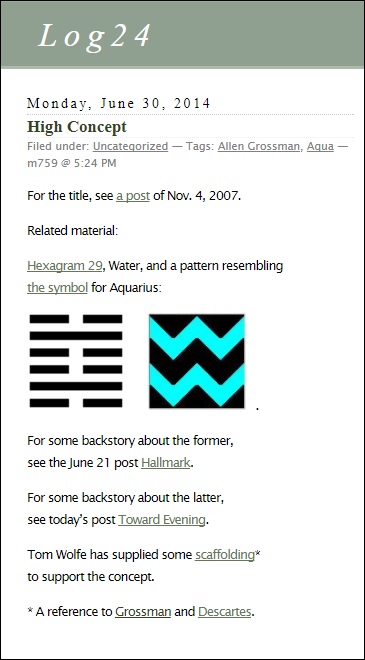Tuesday, September 5, 2017
"But unlike many who left the Communist Party, I turned left
rather than right, and returned—or rather turned for the first time—
to a critical examination of Marx's work. I found—and still find—
that his analysis of capitalism, which for me is the heart of his work,
provides the best starting point, the best critical tools, with which—
suitably developed—to understand contemporary capitalism.
I remind you that this year is also the sesquicentennial of the
Communist Manifesto , a document that still haunts the capitalist world."
— From "Autobiographical Reflections," a talk given on June 5, 1998, by
John Stachel at the Max Planck Institute for the History of Science in Berlin
on the occasion of a workshop honoring his 70th birthday,
"Space-Time, Quantum Entanglement and Critical Epistemology."
From a passage by Stachel quoted in the previous post —

From the source for Stachel's remarks on Weyl and coordinatization —

Note that Stachel distorted Weyl's text by replacing Weyl's word
"symbols" with the word "quantities." —

This replacement makes no sense if the coordinates in question
are drawn from a Galois field — a field not of quantities , but rather
of algebraic symbols .
"You've got to pick up every stitch… Must be the season of the witch."
— Donovan song at the end of Nicole Kidman's "To Die For"
Comments Off on Annals of Critical Epistemology
Or: Coordinatization for Physicists
This post was suggested by the link on the word "coordinatized"
in the previous post.


I regret that Weyl's term "coordinatization" perhaps has
too many syllables for the readers of recreational mathematics —
for example, of an article on 4×4 magic squares by Conway, Norton,
and Ryba to be published today by Princeton University Press.
Insight into the deeper properties of such squares unfortunately
requires both the ability to learn what a "Galois field" is and the
ability to comprehend seven-syllable words.
Comments Off on Florence 2001
Monday, September 4, 2017
From the Log24 post "A Point of Identity" (August 8, 2016) —
A logo that may be interpreted as one-eighth of a 2x2x2 array
of cubes —

The figure in white above may be viewed as a subcube representing,
when the eight-cube array is coordinatized, the identity (i.e., (0, 0, 0)).
Comments Off on Identity Revisited
(A sequel to the previous post, Up to Date)
"Dr. Sekler lectured around the world, but one trip proved life-changing.
In 1962, the year he married, Dr. Sekler made his first trip to Nepal.
'It was the way it had been for centuries — a beautiful valley filled with
happy, peaceful people. It seemed like Shangri-La,' he told the Harvard
Gazette in 2004."
— Bryan Marquard in The Boston Globe today

See also "Eight is a gate" in this journal.
Comments Off on Labor Date

The obituary for Sekler is somewhat surprising, given that he
reportedly died on May 1, 2017. His burial is also rather late,
according to the Globe —
"A service has been held for Dr. Sekler . . . .
He will be buried Sept. 29 in a cemetery
in Vienna, in his family’s plot."
"A memorial lecture in his honor is planned for November
at the Harvard Graduate School of Design." — The Globe
"All in good time, my little pretty."
Another design note related to May Day 2017 —

Related material —
A Vanderbilt University article titled "The significance of Sheriff Bell’s
dreams at the end of No Country for Old Men," and an obituary from
a Log24 post, "Extreme Aesthetic Distance," of August 27, 2017 . . .

Comments Off on Up to Date

Cover design by Jarrod Taylor.
Book published on July 14, 2015.
For this journal on that date, see posts tagged Perspective.
Comments Off on Perspective
Comments Off on Night at the Museum
Sunday, September 3, 2017

The time is from
a screenshot
of my RSS feed.
"All in good time."
(See this morning's
Mosaic Logic.)
Comments Off on Dead Poet

See also Steely Dan in this journal.

Comments Off on Obit
Search for Stone Logic in this journal.
Comments Off on Sermon

“Lord Arglay had a suspicion that the Stone would be
purely logical. Yes, he thought, but what, in that sense,
were the rules of its pure logic?”
—Many Dimensions (1931), by Charles Williams

While you're waiting …

Click the above illustration for
some remarks on mosaics.
Comments Off on Mosaic Logic
Ivars Peterson in 2000 on a sort of conceptual art —
" Brill has tried out a variety of grid-scrambling transformations
to see what happens. Aesthetic sensibilities govern which
transformation to use, what size the rectangular grid should be,
and which iteration to look at, he says. 'Once a fruitful
transformation, rectangle size, and iteration number have been
found, the artist is in a position to create compelling imagery.' "
— "Scrambled Grids," August 28, 2000
Or not.
If aesthetic sensibilities lead to a 23-cycle on a 4×6 grid, the results
may not be pretty —

From "Geometry of the 4×4 Square."
See a Log24 post, Noncontinuous Groups, on Broomsday 2009.
Comments Off on Broomsday Revisited
Saturday, September 2, 2017

This post was suggested by the names* (if not the very abstruse
concepts ) in the Aug. 20, 2013, preprint "A Panoramic Overview
of Inter-universal Teichmuller Theory," by S. Mochizuki.
* Specifically, Jacobi and Kummer (along with theta functions).
I do not know of any direct connection between these names'
relevance to the writings of Mochizuki and their relevance
(via Hudson, 1905) to my own much more elementary studies of
the geometry of the 4×4 square.
Comments Off on A Touchstone
(A prequel to an Ursula K. Le Guin story
in Fantastic magazine, September 1962)


Cover art by Lloyd Birmingham for "Plane Jane"
Comments Off on Try to Remember the Kind of September
Ursula K. Le Guin, in Amazing Stories , Sept. 1992, published
"The Rock That Changed Things" (pp. 9-13) and her story from
thirty years earlier, "April in Paris" (Fantastic Stories , Sept. 1962.)
The latter (pp. 14-19) was followed by some brief remarks (p. 19)
comparing the two stories.
For "The Rock," see Le Guin + Rock in this journal.
"April in Paris" is about time travel by means of an alchemist's
pentagram. The following figure from 1962 is in lieu of a pentagram —

See as well a search for 1962 in this journal.
Comments Off on Knight Moves
Friday, September 1, 2017
On Ursula K. Le Guin's short story
"The Rock That Changed Things"
(in A Fisherman of the Inland Sea ) —
|
From https://www.academia.edu/9496639/
Study_Guide_for_the_Stories_Collected_in_
Ursula_K._Le_Guins_
FISHERMAN_OF_THE_INLAND_SEA
By Richard D. Erlich, December 2005
… And at this point a wise, old nur, so excellent at maintaining patterns that the obls let him live even after he was maimed, enters the discussion to do some pattern criticism. For a first-order approximation reading, he suggests "It might say, 'The nur places stones,'" and others fill in that the nur would be Bu. Ko corrects them with "patterns aren't ever about nurs!" and Bu counters with "Maybe patterns made of colors are." Looking with all three of his eyes, Ko reads, "—'the nur places stones beautifully in uncontrollable loopingness …. foreshadowing the seen.'" Un suggests "The vision" but cannot figure out the last word. Bu is very excited, inferring that "the patterns of the colors …. aren't accidental. Not meaningless. All the time, we have been putting them here in patterns—not just ones the obls design and we execute, but other patterns—nur patterns—with new meanings." Amid the straight lines of the obls' designs they now see, "other designs, less complete, often merely sketched or hinted—circles, spirals, ovals, and complex curvilinear mazes and labyrinths of great and unpredictable beauty and significance. *** Both patterns were there; did one cancel the other, or was each part of the other? It was difficult to see them both at once, but not impossible." Had the nurs done this all totally unconsciously "without even knowing we were doing it?" Un admits to having looked at colors, and so did Ko, plus "grain and texture." Un warns them to keep word of their works from the Professors: "They don't like patterns to change…. It makes them nervous"— and nervous Professors are dangerous to nurs (62-63).
Bu, however "was so excited and persuasive" about colors of stones "that other nurs of Obling began studying the color patterns, learning how to read their meanings." And the practice spreads. Soon, all sorts of nurs were finding "wild designs in colored stones, and surprising messages concerning obls, nurs, and blits" (64) Conservative nurs— "Many nurs," we're told—resist the trend. "If we start inventing new meanings, changing things, disturbing the patterns, where will it end?" It is unclear just how many of the nurs believe «Mr. Charlie treats us real good»—or, as we soon see, Ms. Charlie—but certainly not Bu; she "would hear none of that; she was full of her discovery. She no longer listened in silence. She spoke." Bu goes up to the Rectory Mosaic, wearing around her neck a turquoise that she calls her "selfstone." Up at the Mosaic, Bu crouches before the Rectoress and asks "Would the Lady Rectoress in her kindness answer a question I have?"
["The Rock That Changed Things" was first published in Amazing Stories , Vol. 67 # 6, No. 574, September 1992, pp. 9-13.]
|
For an alternative to the Rectoress, see the Abbess of the previous post.
Comments Off on Patterns for the Abbess
A detail from the previous post —

See as well Ursula in this journal.
Comments Off on Detail
Comments Off on But Seriously…
Comments Off on Harvey’s Tulips
Comments Off on That Old Jew
See references to Krell in this journal.
IMDb > Chief Quinn (Character)
From Forbidden Planet (1956) —
Chief Engineer Quinn: I'll bet any quantum mechanic
in the service would give the rest of his life to fool around
with this gadget.
Related material from the above search for Krell —

Comments Off on Krell’s Journal
Thursday, August 31, 2017
The actor who played Chief Engineer Quinn in the classic
1956 film Forbidden Planet reportedly died today at 91.
In his memory, here is a link from the previous post —
July 15, 2004. Excerpts from that 2004 post —
|
Answers to the first crossword puzzle —

. . . .
Here is an illustration of what might
be called, as in the above puzzle, a
“ten miles pit,” from Forbidden Planet . . . .

|
Comments Off on Forbidden Crossword
(Continued)
|
Filed under: Uncategorized — m759 @ 3:33 AM
The New York Times this morning, in an
obituary for a maker of crossword puzzles :
"… the first known crossword puzzle appeared in
an American newspaper. (Called a 'word-cross'
and shaped like a diamond, it was published in
The New York World on Sunday, Dec. 21, 1913.)"
See St. Nicholas magazine, November 1874, p. 59 :

For the answer, see this journal on Aug. 29, 2002
(with a scene from Spellbound ) and on July 15, 2004.
|
The 1913 puzzle from above, claiming priority —

A more sophisticated puzzle related to the previous post —

Comments Off on Autistic Enchantments
In a book to be published Sept. 5 by Princeton University Press,
John Conway, Simon Norton, and Alex Ryba present the following
result on order-four magic squares —

A monograph published in 1976, “Diamond Theory,” deals with
more general 4×4 squares containing entries from the Galois fields
GF(2), GF(4), or GF(16). These squares have remarkable, if not
“magic,” symmetry properties. See excerpts in a 1977 article.
See also Magic Square and Diamond Theorem in this journal.
Comments Off on A Conway-Norton-Ryba Theorem
Wednesday, August 30, 2017
Or: Bee Season Continues
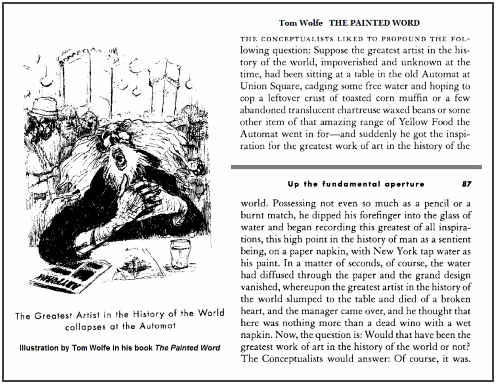
Click the automat image above to enlarge.
Click the Horn & Hardart image below for the source.

See as well Catskills Heaven (Log24 on August 20, 2017) —
The Coen brothers, 2007 screenplay —

(From a novel by Cormac McCarthy)
Comments Off on Horn and Hard Art

"The warnings come after the spells." — Doctor Strange
* See the footnote to the previous post.
Comments Off on The Grossman Chronicles* Continue
( Not the name of Willem de Kooning. )

Click to enlarge.
* See as well some related posts.
Comments Off on Whose Name Was Writ* in Water
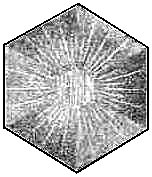
From a Log24 search
for Escher Verbum
Comments Off on Verbum
Tuesday, August 29, 2017
Comments Off on High Concept WW
An image in memory of a publisher* who reportedly died
on Saturday, August 26, 2017.
He and his wife wrote a novel, The Twelve , that has been compared to
the classic film "Village of the Damned." (See a sequel in this journal.)

For more on the image, see posts now tagged The Finkelstein Talisman.
*

Comments Off on The Finkelstein Talisman
The previous post, together with the New York Times Wire and the
life in Trieste of the James Joyce family, suggests a review of …
1. Lucia + Crossword in this journal
2. The following Times items —

Discuss.
Comments Off on Signs of the Times
The New York Times online today —

Taylor Swift's new video —

For Taylor, news from St. Lucia's Day (Dec. 13) 2016 —
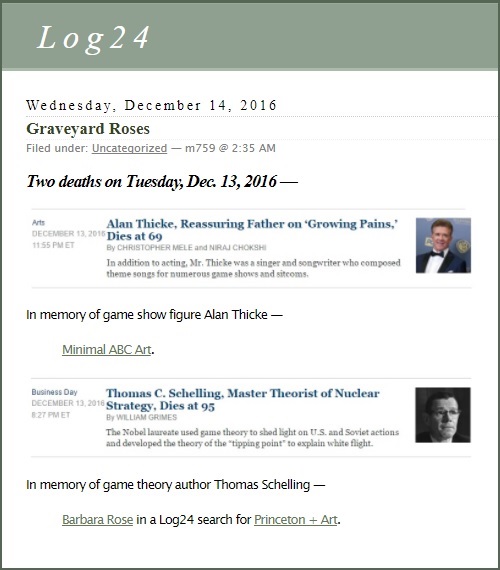
Comments Off on Times Style vs. Taylor Swift
Continued from August 23, 2017. See a death on that date
reported by a funeral home in Monterey, California.

Comments Off on Pakanga

From a Log24 search for "Midnight Special."
Update of 12:45 AM the same night —
"I appreciate simple, iconic and timeless forms —
things that can adapt or serve multiple purposes
and avoid being easily labelled. At the same time,
I love parts and fragments that reveal how things
move or work. Mostly, anything that tells its
own story and isn’t generalized or clad in some
sort of ornamental icing."
— Charlottesville, VA, architect Fred Wolf, who seems
to have been associated with the business name
"Gauss LLC " in Charlottesville.
And I appreciate bulk apperception.
Comments Off on Midnight Special
Monday, August 28, 2017
"Analysis." — Dr. Robert Ford in "Westworld." See related posts.

This journal on August 18, 2017 —

Comments Off on Analysis
Comments Off on April 1 Instagram

See Captain America's special breakfast
in posts tagged Aesthetic Distance.
See as well Taylor Swift in the previous post and
The School of the New York Times on creating
great branded content:



Comments Off on Narratives
Or: Modern Muse (Continued from August 1, 2017)
Click to enlarge.


Comments Off on Look What You Made Me Do
Sunday, August 27, 2017

See also earlier posts tagged Profiling Trump.

Comments Off on Profiling
“I need a photo opportunity, I want a shot at redemption.
Don’t want to end up a cartoon in a cartoon graveyard.”
— Paul Simon


See also John Collier's short story "The Lady on the Grey."
Note that the title of the previous post was "Black Well,"
almost the same as that of Tanner's graphic novel above.
Comments Off on Sequel (In Memory of Tobe Hooper)
The “Black” of the title refers to the previous post.
For the “Well,” see Hexagram 48.
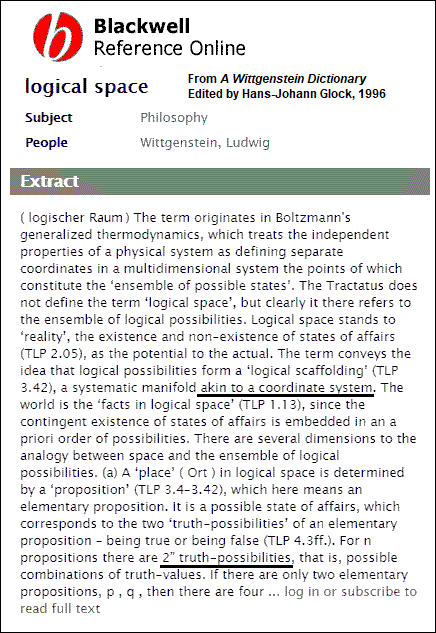
Related material —
The Galois Tesseract and, more generally, Binary Coordinate Systems.
Comments Off on Black Well
The previous post suggests an example of
extreme aesthetic distance.
The word "mosaic" in Max Black —

The same word in a very different author —

Related historical remarks, for the Church of Synchronology —

The above death reportedly occurred on Sunday, Sept. 13, 2015.
This journal at 11 AM on that date —

Some background —

Comments Off on Extreme Aesthetic Distance
Saturday, August 26, 2017

Naive readers may suppose that this sort of thing is
related to what has been dubbed "geometric group theory."
It is not. See posts now tagged Aesthetic Distance.

Comments Off on Aesthetic Distance
Or: The Confines of Reason


"The confines of reason" vs. the confines of time —
The previous post noted that …
Schorske mentioned hopefully "the fresh light of
the present" in 1971.
Some later light [came] from Brian Aldiss in his novel
Frankenstein Unbound , first published in 1973.
Between these two years, in 1972, the band Looking Glass
released what has been called
"one of Earth's greatest musical compositions, perhaps the greatest."
Comments Off on A Looking-Glass War

|
The Seventh Function
of Language
A novel by Laurent Binet
The New York Times
online Aug. 16, 2017,
in a book review —
"What if . . . Barthes was murdered? . . . in order to
procure a document that Barthes possessed . . . .
That document explained that, beyond the six
functions of language proposed by the Russian
linguist Roman Jakobson, there was a seventh
secret one: an occult kind of language-use
guaranteed to persuade, a 'magic' power of
control over a listener."
|
Schorske mentioned hopefully "the fresh light of
the present" in 1971.
Some later light from Brian Aldiss in his novel
Frankenstein Unbound , first published in 1973 —

Comments Off on The Seventh Door Meets the Seventh Function
Friday, August 25, 2017
The above is a variation on a title from last night's post By Degrees.
The Literary Path —

The Hollywood Path —

Further remarks on algebra and space —

See as well the above image in yesterday's post Maori Chess, Vol. 2.
Comments Off on Two Paths for the Impersonal Essay
Comments Off on In Memoriam
http://m759.net/wordpress/?s=Gaitskill
The above link was suggested by the essay
of the previous post.
Comments Off on Midnight with Gaitskill
Thursday, August 24, 2017


Emre is the author of the recent "Two Paths for the Personal Essay."
Comments Off on By Degrees
http://m759.net/wordpress/?s=Kristeva
http://m759.net/wordpress/?s="Tel+Quel"
http://m759.net/wordpress/?s=Sollers
Some context for the new novel The Seventh Function —
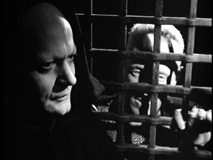
Click image to search Log24 for Gitterkrieg .
Comments Off on Gitterkrieg
This just in …

From IMDb —

From Radio New Zealand —
"Genesis Potini died of a heart attack aged 46
on the 15th August 2011."
The 15th of August in New Zealand overlapped
the 14th of August in the U.S.A.
From a Log24 post, "Sunday Review," on August 14, 2011 —
Part II (from "Marshall, Meet Bagger," July 29):
"Time for you to see the field."

For further details, see the 1985 note
"Generating the Octad Generator."
McLuhan was a Toronto Catholic philosopher.
For related views of a Montreal Catholic philosopher,
see the Saturday evening post.
Comments Off on Maori Chess, Vol. 2


The Decepticons date above, June 21, 2017, suggests an instance of
that date in this journal —

For the Church of Synchronology, a New York Times item from
the above death date, June 21, 2017 —

See as well Kurt Russell in Guardians of the Galaxy, Vol. 2 —

Some relevant context: Expanding the Spielraum .
Comments Off on Maori Chess
Wednesday, August 23, 2017
See Deceivers and Wargames in this journal.
Comments Off on Deceivers’ Wargames
A designer from New Zealand —

Happy 10th birthday to the hashtag.

Comments Off on The Diamond Theorem in Vancouver
("Every Picture Tells a Story," continued from August 15 )


Related material — Laughing-Academy Cartography.
Comments Off on Pakanga
Tuesday, August 22, 2017
College to Pilot Pre-Orientation Program
for Members of
'Historically Marginalized Communities'
— Headline in The Harvard Crimson , Saturday, August 19, 2017
You know the walls along the border?
They're building them with the
landing pads we used in 'Nam.
Think about that.
—— "Preacher"
Read more:
https://www.springfieldspringfield.co.uk/
movie_script.php?movie=blood-father
Comments Off on Preacher
“The interrupted flow of the new poetic language
initiates a discontinuous nature,
which is only revealed piecemeal." — Roland Barthes
From Le degré zéro de l'écriture , published in 1953 by Editions du Seuil ,
translated into English by Annette Lavers and Colin Smith as
Writing Degree Zero and published in 1967 by Jonathan Cape Ltd.


Comments Off on Interrupted Flow

From a 2009-2016 exhibition by David Link
Related material —
|
The object now sails slowly ahead, before starting to climb up and up, until it docks some way up in the discourse. And it sits there glowing. Yes, in an elevated position, just as Roland Barthes describes it in Writing Degree Zero . We let the magnifying glass glide over Barthes’s text, and see the word “discontinuous.” We carefully study a sentence we love: “The interrupted flow of the new poetic language initiates a discontinuous nature, which is only revealed piecemeal. At the very moment when the withdrawal of functions obscures the relations existing in the world, the object in discourse assumes an exalted place.” It is absolutely no surprise that at this point we have the picture of a luminous green prism sailing in through the dark and taking an exalted place on our retina, a bit like when you’ve been staring too hard at a lamp on the ceiling and then close your eyes! How strange, we think, that a sentence that was written to explain an aspect of modern poetry can have roughly the same effect on our imagination as science fiction. In particular, the phrase A DISCONTINUOUS NATURE, WHICH IS ONLY REVEALED PIECEMEAL makes us imagine a vast darkness and then rectangular blocks of bright green sections of nature, and they are not lined up as such, but appear in flashes. The blocks of bright green and sudden nature appear in flashes.
— Gunnhild Øyehaug, from
"The Object Assumes an Exalted Place in the Discourse,"
in Knots: Stories (pp. 139-140).
Farrar, Straus and Giroux. Kindle Edition.
Knots was first published in 2004, in Norwegian.
|
Comments Off on Link Degree Zero
Monday, August 21, 2017
Continued. Alexander Pope —
"Heaven from all creatures hides the book of Fate,
All but the page prescribed, their present state:
From brutes what men, from men what spirits know:
Or who could suffer being here below?"
Comments Off on Immersion
Sunday, August 20, 2017

The New York Times today —
"His parents, Danny and Rae Levitch, were entertainers —
his father a song-and-dance man, his mother a pianist —
who used the name Lewis when they appeared in
small-time vaudeville and at Catskills resort hotels."
The Coen brothers, 2007 screenplay —

(From a novel by Cormac McCarthy)
Comments Off on Catskills Heaven
"Clog, therefore, purple Jack and crimson Jill." — Wallace Stevens
|
"A 1991 PBS documentary called Dancing Outlaw introduced the world to the life and times of gas-huffing, vengeance-seeking, tap-dancin’ Jesco White. White Lightnin’ , which premiered recently at Sundance, is British director Dominic Murphy’s reportedly more surreal take on this fabled Appalachian anti-hero. While not locked in reform school, work camps, or the psych ward, the young Jesco White learned his special breed of clog dancing from his father, who was eventually killed in a random act of hillbilly violence. In White Lightnin' Jesco picks up his daddy’s tap shoes and hits the road, where he comes to grips with the art, addiction, and madness that have plagued his violent life story. And somewhere along the way he meets his wife, played by none other than Carrie Fisher. While David D’Arcy speaks almost fondly of White Lightnin' s redneck-exploitation (he was probably stretching for other ways to describe this “hillbilly slasher saga”), Dennis Harvey was less enchanted by the film’s 'pretentious glimpse of hillbilly hell.' Most early reviews are apprehensive about the film’s distribution chances unless its grotesque lyricism finds a niche market. But I can't imagine this, being the first film written by the co-founders of Vice Magazine , not generating more distribution steam in the near future. If anyone knows how to generate buzz it is those guys."
— MLeary review, January 28, 2009, 12:58 AM
|

Comments Off on Hillbilly Hell
Decorations for a Cartoon Graveyard, Continued .

See also some remarks by Wallace Stevens
from a 2016 post "For Crimson Jill."

Comments Off on Sermon:
Comments Off on Enigmatic and Circuitous
Saturday, August 19, 2017
From a political kingmaker's online NY Times obituary this evening —
" 'I have been criticized for 20 years for running
ideologically arched campaigns,' he told the National
Conservative Political Action Conference in 1991. 'I plead guilty.' "
To check the unfamiliar usage "ideologically arched," see minute 35:02 on
the linked video. The word may actually have been "harsh," not "arched."
For an arched campaign, see the previous post, App . Some background —
A Village Voice —
"Arthur Jay Finkelstein was born on May 18, 1945, in the East New York
section of Brooklyn, the son of Jewish immigrants from Eastern Europe.
His father, Morris, was a cabby. His mother was the former Zella Ordanksi.
The family moved to Levittown, on Long Island, when he was 11, then to
Queens, where he graduated from Forest Hills High School.
In 1967, Mr. Finkelstein earned a bachelor’s degree in economics and
political science from Queens College. As a student, he sometimes shared
a college radio program with Ayn Rand, the author and philosopher whose
laissez-faire capitalism he would fiercely defend in street-corner debates in
Greenwich Village." — Sam Roberts of The New York Times
Comments Off on Arched
From a trailer for the 2013 Dutch film "App" —


From the online New York Times yesterday —

See also Overarching + Symmetry in this journal.

Comments Off on App
Friday, August 18, 2017

Shermer, Thompson; Thompson, Shermer.
"In this one book, Thompson’s muse
seems to have led him perfectly."
— Stephen King, 2011 foreword to a 1952 novel:

See also Shermer in this journal.
Comments Off on Killer
Comments Off on Quarter to Four
Flashback in Genial, a post of March 6, 2017 —


From a New York Times book review today by
James Ryerson, instructor at The School of The New York Times —
"Savvy philosophers distill their core insight into a short phrase."

"Let them eat cake."
Comments Off on The Savvy Philosophers
Thursday, August 17, 2017

See also other posts now tagged Jungle Room.
Comments Off on Down in the Jungle Room
Operation Blockhead continues …


See also Weyl + Palermo in this journal.
Comments Off on For Time Cube Fans
This post was suggested by a detail, the number 777, on the cover of the
American edition of the novel discussed in yesterday morning's post Punctum.
|
m759 @ 11:07 PM
“Teach us to
number our days.”
– Psalm 90, verse 12
The New Yorker,
issue dated Oct. 1, 2007 —
James Wood on Robert Alter’s
new translation of the Psalms:
“At any time, God can cancel a life. ‘So teach us to number our days,’ as the King James Version has it, ‘that we may apply our hearts unto wisdom.’….
The ancient Hebrew word for the shadowy underworld where the dead go, Sheol, was Christianized as ‘Hell,’ even though there is no such concept in the Hebrew Bible. Alter prefers the words ‘victory’ and ‘rescue’ as translations of yeshu’ah, and eschews the Christian version, which is the heavily loaded ‘salvation.’ And so on. Stripping his English of these artificial cleansers, Alter takes us back to the essence of the meaning. Suddenly, in a world without Heaven, Hell, the soul, and eternal salvation or redemption, the theological stakes seem more local and temporal: ‘So teach us to number our days.’”
Today’s numbers from the
Pennsylvania Lottery:

which, being interpreted,
is 5/10 and 7/24.
Selah.
|
Comments Off on Numbered
Wednesday, August 16, 2017
Or: Every Picture Tells a Story (Continued)

Related material —
The New York Times online today, in a book review —
"What if . . . Barthes was murdered? . . . in order to
procure a document that Barthes possessed . . . .
That document explained that, beyond the six
functions of language proposed by the Russian
linguist Roman Jakobson, there was a seventh
secret one: an occult kind of language-use
guaranteed to persuade, a 'magic' power of
control over a listener."
See also Barthes in this journal.
"Down in the Jungle Room" — Marc Cohn
Comments Off on Punctum
Tuesday, August 15, 2017
Comments Off on The Uploading

See also Dark Tower in this journal.
Comments Off on To the Dark Tower
Hexagram 15:
Modesty



See also remarks today by David Brooks at The New York Times .
Comments Off on Every Picture Tells a Story
Monday, August 14, 2017
Comments Off on Chess Records
Two songs by Chuck Berry on Chess Records in 1958 —
Sweet Little Sixteen and Sweet Little Rock and Roller .
Rock and Roller begins …
She's 9 years old and sweet as she can be
All dressed up like a downtown Christmas tree
Dancin' and hummin' a rock-roll melody
For meditations on Sixteen , see Berry + Sixteen in this journal.
A meditation on Rock and Roller —

Related material — From the above post's date,
March 21, 2017, a memoir by one Siva Vaidhyanathan,
"Robertson Professor of Media Studies and Director of
the Center for Media and Citizenship at the University of Virginia."
Comments Off on Sound Track
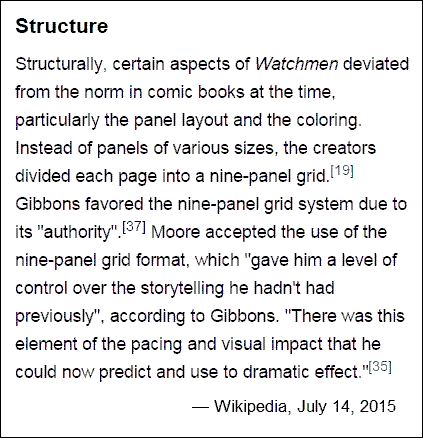
See also posts now tagged "Go Set."
Comments Off on Visual Impact
Sunday, August 13, 2017
From The Atlantic , September 2017 issue, online —
"How America Lost Its Mind," by former Harvard Lampoon
writer Kurt Andersen —

The Atlantic 's embedded Google ad for "Quantum Space Elements"
is, by the way, completely unrelated to similar-sounding work on
models of space in finite geometry (cf. tsimtsum ) . . .

Comments Off on Compare and Contrast
"We have passed through the looking glass
and down the rabbit hole."
— Kurt Andersen in the Sept. 2017 Atlantic
See as well "the desert of the real" and,
for comparison, College of the Desert in this journal.
Comments Off on The Red Pill

See also last night's post Logos .
Comments Off on Limit Sermon


In memoriam —


Zadeh is known for the unfortunate phrase "fuzzy logic."
Not-so-fuzzy related material —
“Lord Arglay had a suspicion that the Stone would be
purely logical. Yes, he thought, but what, in that sense,
were the rules of its pure logic?”
—Many Dimensions (1931), by Charles Williams

Comments Off on Logos
Saturday, August 12, 2017
For the author of a Harvard Crimson opinion piece yesterday on 1984 ,
two images adapted from a 1984 film —


See also, in this journal, Hume's phrase "perfect nonentity."
Comments Off on Images from 1984
Friday, August 11, 2017
A post suggested by the word tzimtzum (see Wednesday)
or tsimtsum (see this morning) —
Lifeboat from the Tsimtsum in Life of Pi —

Another sort of tsimtsum, contracting infinite space to a finite space —

Comments Off on Symmetry’s Lifeboat
"Much like the irrational number pi,
the primal tsimtsum transforms
an infinite circle into a measured line."
— Tzvi Freeman at Chabad.org

The College Mathematics Journal , 46, No. 3 (May 2015), pp. 162–171
Comments Off on Archimedes for Jews
Thursday, August 10, 2017
Comments Off on Gravity’s Countdown
Wednesday, August 9, 2017

For those whose only interest in mathematics
is as a path to the occult —

See also Coxeter's Aleph.
Comments Off on Implosion

"She wrote her doctoral thesis, which was supervised
by Friedrichs, on the stability of a spherical implosion
and was awarded her Ph.D. in 1951."
— MacTutor
See also a related Google Image Search.
For images from the reported date of Morawetz's death,
see Theology for Child Buyers.
Update of 2:56 PM ET Friday, August 11, 2017 —
Legacy.com and NYU now report that Morawetz died
on Tue., Aug. 8, not, as the AMS reported, on Mon., Aug. 7.
(The AMS has now corrected its error.)
For sloppiness about mathematics that echoes this
sloppiness about dates, see a post of Tue., Aug. 8.
Comments Off on Stability
"Fire and Fury is one of the most popular
historical military miniatures wargames . . . .
For the new player it is an easy game
to learn and enjoy."
— fireandfury.com

Comments Off on War Game: 8/09
Tuesday, August 8, 2017


Exercise:
Discuss whether Knudson's phrase "essentially says" is correct.
For the Church of Synchronology —
The above Forbes article is dated July 29, the date of death for
Landon T. Clay, founder of Clay Mathematics Institute.
For remarks related to that date, see posts tagged Prize Problem
in this journal.
Comments Off on July 29 Podcast
Comments Off on Cube Quaternions
Monday, August 7, 2017

Don't forget the apple.
Comments Off on Snowflakes and Unicorns


See also Noon for London in this journal on the
above "Starting to See Pictures" upload date in 2016.
For a tale about that date, April 4, see today's noon post.
Comments Off on Putting the “Times” in “New York Times”

From Blockbuster, a post of Friday, August 4, 2017 —
The article suggests a look at a July 3 Times review of the life
of Jan Fontein, a former Boston Museum of Fine Arts director —
"Mr. Fontein’s time as director coincided with
the nationwide rise of the blockbuster exhibition,
and he embraced the concept. 'There was such a thing
as a contemplative museum, but I don’t think that can
survive anymore,' he told Newsweek in 1978."
From The New York Times this evening —
"Mr. Roth made his mark at the Victoria and Albert
with record-breaking exhibitions focused on
David Bowie in 2013, Alexander McQueen in 2015
and The Beatles and the youth revolution of the 1960s
in 2016."
Related material —
Record-breaking in this journal and Sunday in the Park with Death.
Comments Off on Pathbreaking
Comments Off on Theology for Child Buyers
"Serve in Heaven …
or reign in Hell?
Which is it to be?"
— David in "Alien: Covenant" (2017)
Other mythological tales —
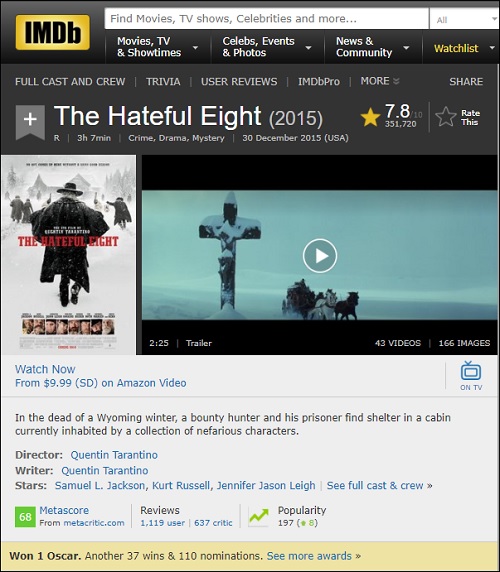
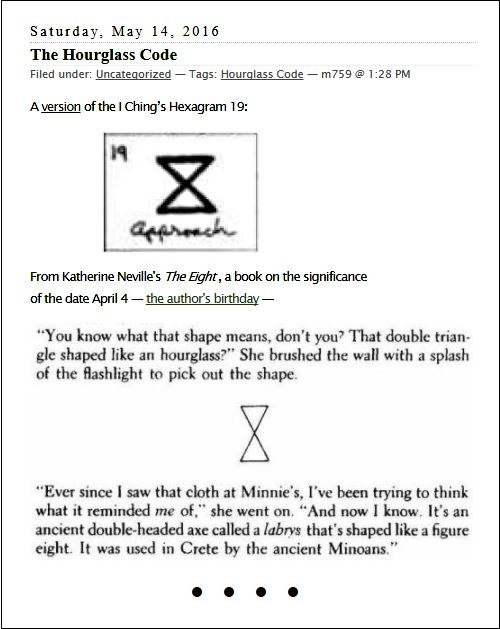

Comments Off on Theology for Westworld
Sunday, August 6, 2017

In memory of a TV gunslinger who reportedly died Thursday, August 3, 2017 . . .
From this journal on that day (posts now tagged Dark Tower Theology) —
"The concept under review is that of the Holy Trinity.
See also, in this journal, Cube Trinity.
For a simpler Trinity model, see the three-point line …"

"Would that it were so simple."
Comments Off on Dark Tower Theology
Recent remarks related to the July 29 death of Landon T. Clay
suggest a review of a notable figure associated with Clay.
From a 2006 obituary of mathematician George Mackey —
"A deep thinker whose work in representation theory,
group actions, and functional analysis helped
bring closer together the fields of math and physics,
Dr. Mackey died March 15 of complications from
pneumonia. He was 90, had lived in Cambridge, and
was Landon T. Clay professor emeritus at Harvard University."
— Bryan Marquard, Boston Globe, April 28, 2006
See also this journal on the date of Mackey's death (posts now tagged
Ides of March 2006).
Comments Off on Ides of March 2006
"Simone Weil said that morality
was a matter of attention not of will.
We need a new vocabulary of attention."
— Iris Murdoch, "Against Dryness"
Comments Off on Attention
Saturday, August 5, 2017
"A tight story is one thing, but a 95-minute feature
that is unable to give even the slightest inkling
that it’s based on a grand-scale epic masterpiece
is something else entirely."
— Kate Erbland, "The Dark Tower" film review
at IndieWire.com, Aug. 2, 2017
From a not-so-slight Inkling, a word to the wise —

— From an editorial glossary to "Ósanwe-kenta," by J.R.R. Tolkien
See as well posts now tagged Enda's Game.
Comments Off on Inkling
Friday, August 4, 2017
Landon T. Clay, founder of the Clay Mathematics Institute,
reportedly died on Saturday, July 29, 2017.
See related Log24 posts, now tagged Prize Problem,
from the date of Clay's death and the day before.
Update of 9 PM ET on August 4, 2017 —
Other mathematics discussed here on the date of Clay's death —
MSRI Program. Here MSRI is pronounced "Misery."
Update of 9:45 PM ET on August 4, 2017 —

Comments Off on Clay
This post was suggested by a New York Times article online today
about an upcoming exhibition at Boston's Museum of Fine Arts —
"A version of this article appears in print on August 6, 2017,
on Page AR2 of the New York edition with the headline:
Art; Woodblock Smackdown!."
The article suggests a look at a July 3 Times review of the life of
Jan Fontein, a former Boston Museum of Fine Arts director —
"Mr. Fontein’s time as director coincided with
the nationwide rise of the blockbuster exhibition,
and he embraced the concept. 'There was such a thing
as a contemplative museum, but I don’t think that can
survive anymore,' he told Newsweek in 1978."
Fontein died at 89 on May 19, 2017. See Dharmadhatu — a Log24 post
of July 4, 2017 — and its link to posts tagged May 19 Gestalt.
Comments Off on Blockbuster
Thursday, August 3, 2017
"The centre of transformations that
Transform for transformation's self,
In a glitter that is a life, a gold
That is a being, a will, a fate."
— Wallace Stevens, "Human Arrangement"
From "The Dark Tower," a post of July 9, 2016 —

See also a search for Glitter in this journal.
Comments Off on Glitter at the Dark Tower
Or: Trinity Test Site

From the New York Times Book Review of
next Sunday, August 6, 2017 —
"In a more conventional narrative sequence,
even a sequence of poems,
this interpenetration would acquire
sequence and evolution." [Link added.]
The concept under review is that of the Holy Trinity.
See also, in this journal, Cube Trinity.
For a simpler Trinity model, see the three-point line …

Comments Off on Poetic Theology at the New York Times
Wednesday, August 2, 2017
"It's clear that you believe nothing will ever outrank
your cold and unforgiving erudition,
however, everything you think is based,
even at the most basic neuronal level,
on the way you connect a long line of dots."
— Mary Jo Bang, "The Game of Roles" (Summer 2016)
See as well posts tagged Dots in this journal.
Related material at a basic level —

See also History of Geometry in this journal.
Comments Off on Cold and Unforgiving Erudition
(To the previous post)

For the rest of the prequel, see New York Values (Jan. 17, 2016).
Comments Off on Prequel …
Comments Off on End of Feed
Comments Off on Wallace Stevens died when I was a boy …
(Continued)

"Refined interpretation requires that you know that
someone once said the offspring of reality and illusion
is only a staggering confusion."
— Poem, "The Game of Roles," by Mary Jo Bang
Related material for those perplexed by such Verhexung —

Comments Off on Verhexung
Tuesday, August 1, 2017
The title is that of the cover essay in
the Sunday, August 6, 2017, issue
of The New York Times Book Review .
From a poem on page 17 —
"Avoidance of boredom drives the body forward."
By the same poet, Mary Jo Bang —
"A circular mirror of the social order is something
like a master with an exclusive club membership
until a woman comes through the revolving door."
These remarks, and the life of Matthew Vaughn, director of
"X-Men: First Class" and other films (cf. this morning's post
Dichotomy), suggest a review of the Nobel Flashback post
of October 6, 2016. A retitled sample —
Avoidance of Boredom

Comments Off on Poetry in Action
Megan Fox in "Transformers" (2007) —

Background from January 25, 2017 —

"Remembering speechlessly we seek
the great forgotten language,
the lost lane-end into heaven,
a stone, a leaf, an unfound door.
Where? When?" — Thomas Wolfe

Comments Off on Auto Detailing
"National and educational contexts call for
appropriately tailored arguments."
— Gabriel H. Karger in The Harvard Crimson , July 27, 2017,
"Freedom and Final Clubs: The Wrong Dichotomy"
Related material —


Comments Off on Dichotomy

From a 1987 review of the Stephen King novel Misery :
"In other words, for all her craziness, Annie Wilkes
becomes Paul Sheldon's literary muse, and as muses go
she probably isn't too much worse than average,
her main fault being a tendency to punish more literally
than most muses do."
— Christopher Lehmann-Haupt in The New York Times
From the Estée Lauder website :
"Who is a Modern Muse? The description of
our iconic fragrance says it all . . . ."
A rival product —

See all related posts.
Comments Off on Modern Muse
Monday, July 31, 2017
From a June 8, 1987, New York Times review of
Stephen King's novel Misery —

"She doesn't like Fast Cars , the manuscript of which she found
in his traveling bag. It's confusing and the language is profane."
From the IMDb biography of film director Rob Cohen —
"He attended Harvard University and graduated
magna cum laude in the class of '71, concentrating
in a cross major between anthropology and visual studies."
"He is the creator of The Fast and the Furious (2001),
Universal Pictures' biggest franchise of all time."
Cohen also directed Stealth (2005). See a Sam Shepard fan site.
Comments Off on Stealth Cars
Comments Off on Sam Shepard Reportedly Died on Thursday, July 27.
Comments Off on Epiphany 2010
Comments Off on Commercial Aspect
« Newer Posts —
Older Posts »







































